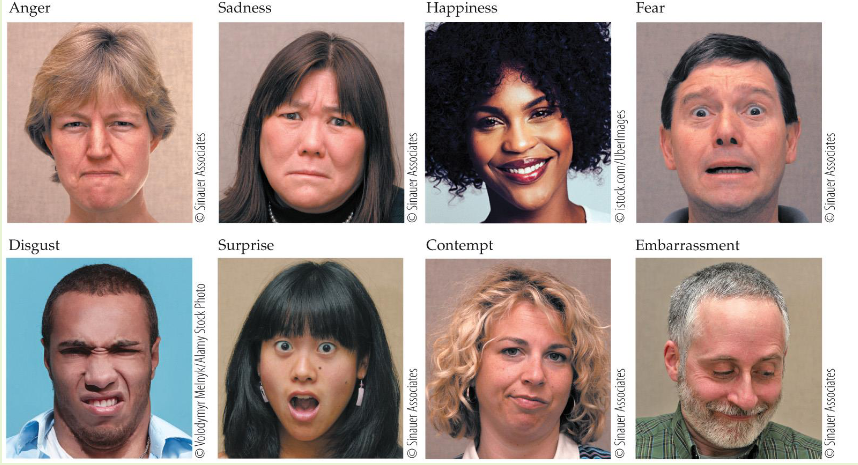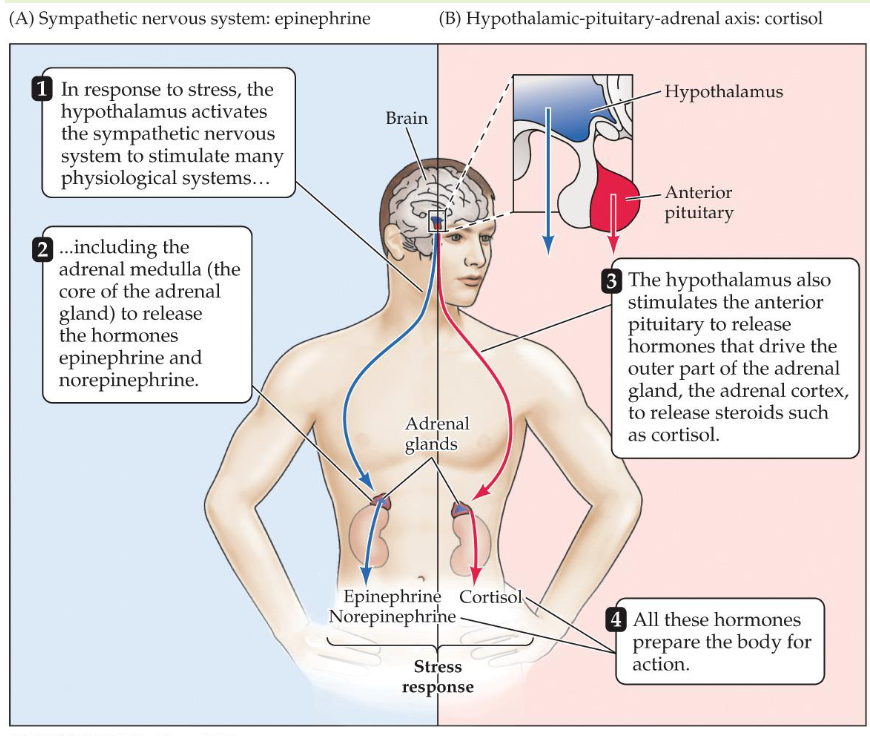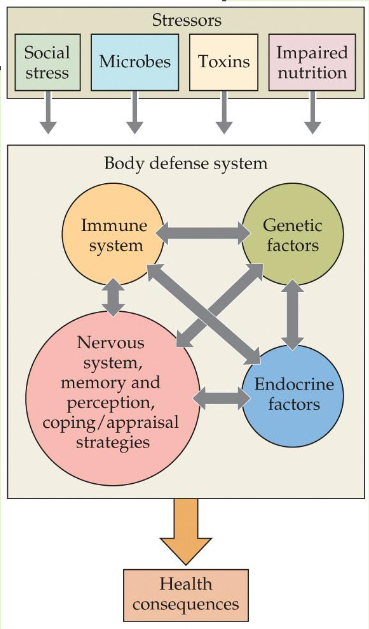Chapter 11: Emotions, Aggression, & Stress
1/35
Earn XP
Description and Tags
Made by @agreyr
Name | Mastery | Learn | Test | Matching | Spaced |
|---|
No study sessions yet.
36 Terms
Emotion
A subjective experience accompanied by distinctive cognition, behavior, and physiological changes
Must be experienced in the body; involves characteristics of valence and arousal
Examples of high arousal, positive valence emotions
Excited, astonished, aroused, delighted, glad, happy
Examples of low arousal, positive valence emotions
Pleased, satisfied, content, serene, calm, at ease, relaxed, sleepy
Examples of high arousal, negative valence emotions
Alarmed, afraid, angry, tense, distressed, annoyed, frustrated
Examples of low arousal, negative valence emotions
Miserable, depressed, sad, bored, gloomy, droopy, tired
Emotion theories
All theories of emotion involve a stimulus, a physiological state, and an emotional experience; the difference lies in which comes first (informs cause and effect)
James-Lange theory, Cannon-Bard theory, Schacter & Singer two factor theory
James-Lange theory of emotion
The stimulus first triggers a physiological response in the body which in turn triggers the emotional experience in the brain; the rapid heartbeat produces the fear

Cannon-Bard theory of emotion
The stimulus simultaneously triggers the physiological response in the body and triggers the emotional experience in the brain; they are parallel processes

Schacter & Singer two factor theory of emotion
Emotions are based on inferences about the causes of general physiological reactions; it has to involve a cognitive appraisal of the current context

Evolution of emotions - Charles Darwin
Emotional expressions are the product of evolution and should be studied across species; human and nonhuman animals show comparable (though often subtle) emotion with universal meanings
Emotional expressions signal what the animal is likely to do next; if emotional signals are beneficial, they will evolve to more effectively communicate
Principle of antithesis
Opposite messages signaled by opposite movements and postures
Are emotions universal?
Likely 6-8 core emotions, consistent across time and culture
People of different cultures make similar expressions; can identify emotions of others, despite different cultures
Paul Ekman & colleagues core emotions
Anger, sadness, happiness, fear, disgust, surprise, contempt, embarassment

Facial feedback
Facial expressions are mediated by muscles, cranial nerves, and CNS pathways
Facial expressions of emotion can be faked; microexpressions can reveal true feelings, and different muscles are involved in real vs fake smiles
Microexpressions
Ultra-brief facial expressions that reveal true feelings by breaking through fake ones
Muscles involved in fake vs real smiles
Orbicularis oculi (Duchenne/genuine) & Zygomaticus major (both)
Facial feedback hypothesis
Voluntarily controlling muscles can influence our emotional experience
Amygdala
Threat detection/appraisal
Responsible for the evaluation of emotion-relevant aspects of a stimulus
Limbic system
Maintain amygdala response or dial it back
Processes higher order information and monitors appropriate amygdala activation
How the system works
Low Road: eye —> thalamus —> amygdala
High Road: eye —> thalamus —> cortex —> amygdala

Evidence for brain regions
Klüver-Bucy Syndrome, Urbach-Wiethe Disease, Sham Rage, fear conditioning
Klüver-Bucy Syndrome
Bilateral amygdala damage causes emotional changes including a reduction of fear and anxiety; initially found in monkeys
Urbach-Wiethe Disease
Calcification of the amygdala leads to the inability to recognize expressions of fear and danger; also a lack of fear
Sham Rage
Cats and dogs with their cortex removed show extreme and unfocused aggressive responses; hypothalamus must remain intact when cortex is removed
Fear conditioning
Establishment of fear response to a previously neutral stimulus (tone); the tone alone comes to elicit freezing and enhanced startle

Aggression
Behavior intended to cause pain or harm
Hormonal contributions to aggression
Androgens seem to increase aggression in animals but story is more complicated in humans
Brain regions involved in aggression
Amygdala & ventromedial hypothalamus
Stress
The physiological changes that result when the body is exposed to harm or threat
Stressor
The experience that induces the stress response (bear, shock, exam, etc.); elicits the same response pattern whether psychological or physical stress
Stress pathways
Sympathetic nervous system (fight or flight, epinephrine) & HPA axis (stress hormone system, cortisol)

Hypothalamic-pituitary-adrenal (HPA) axis
Hypothalamus: Corticotropin Releasing Factor
Pituitary (anterior): Adrenocorticotropic Hormone
Adrenal gland: Cortisol
Hans Selye & stress research
Canadian physician who studied “ovarian extract” - injected rats daily with estrogen or control (saline) to investigate effects on stress
Results: ALL rats developed ulcers, enlarged adrenal glands, and shrinkage of the lymph nodes (stress response to injections)
Generalized Adaptation Syndrome
Three stage physiological stress response that appears regardless of the stressor that is encountered
Phase 1: Alarm reaction (mobilize resources)
Phase 2: Resistance (cope with stressor)
Phase 3: Exhaustion (reserves depleted)

Psychoneuroimmunology
Study of the interaction of psychological factors, the nervous system, and the immune system; includes biological factors

Stress and immune function
Acute stressors improve immune function; chronic stressors impair immune function
Brief stressors activate an inflammatory response (increased cytokines, peptide hormones that cause inflammation and fever)